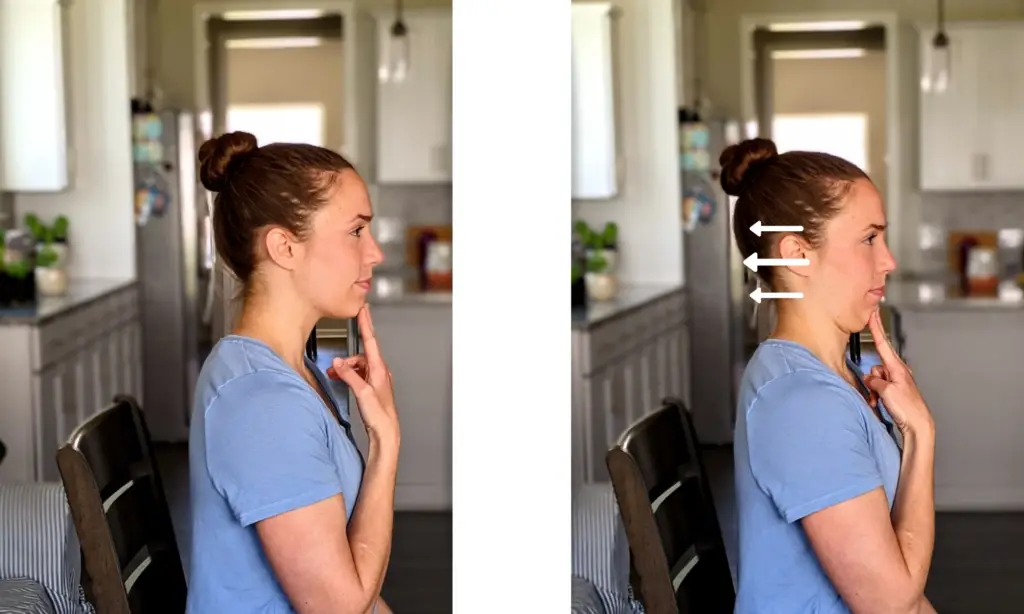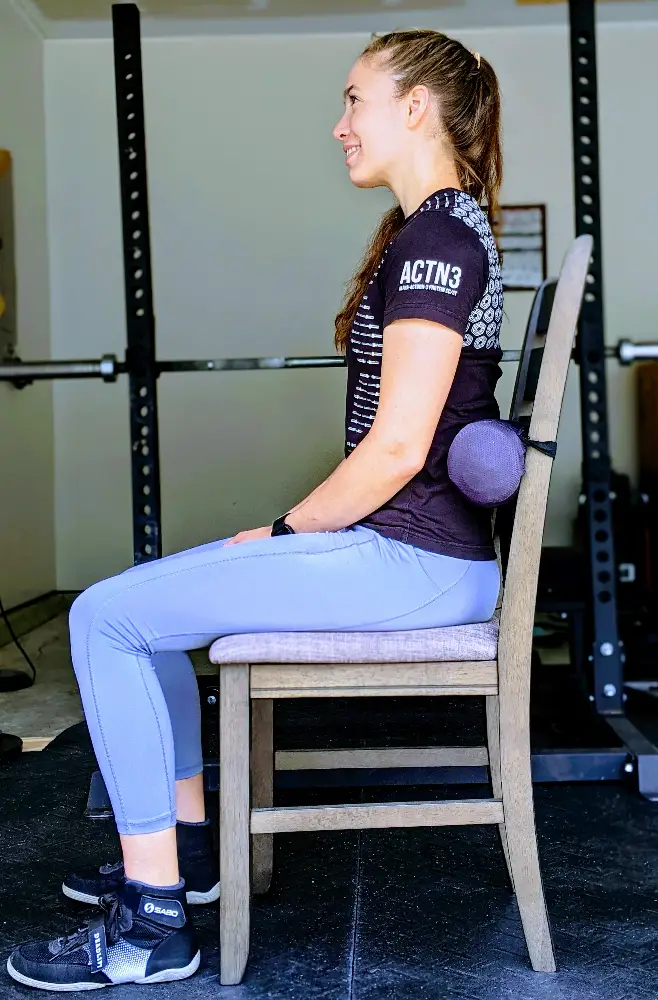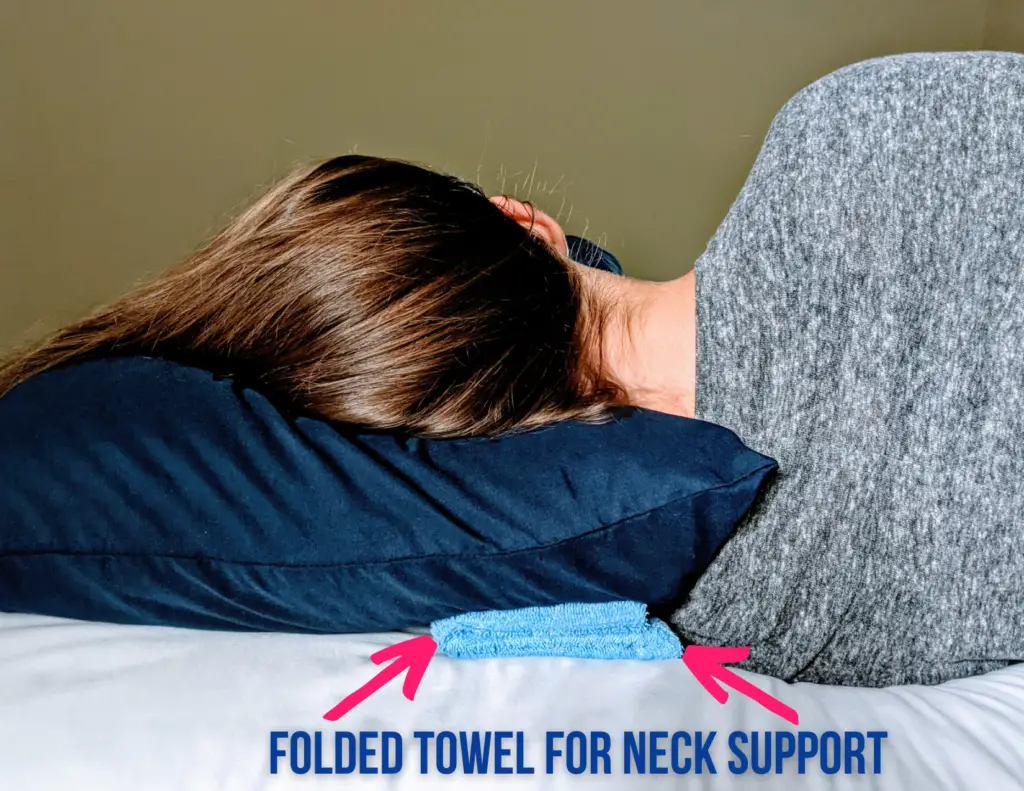One minute you’re asleep. The next minute your alarm blares, jarring you awake. Your neck is aching. Sharp pain makes it impossible to turn your head, much less look behind you to back the car out of the driveway.

Sound familiar? Here are 10 ways to fix the crick in your neck from sleeping wrong.
1) Don’t Panic
It’s normal to expect the worst when dealing with acute neck pain.

But fearing the worst slows down recovery and worsens prognosis. Also known as catastrophization, worst-case-scenario thinking leads to movement avoidance and delayed healing (1).
Neck stiffness is a common occurrence and usually goes away on its own.
If neck tightness is accompanied by “red flag” symptoms like fever, chills, severe headache, or other unusual symptoms, it’s a good idea to see a qualified healthcare provider (like a medical doctor) about your symptoms. A few serious medical conditions can cause neck tightness.
The good news is that most neck pain is musculoskeletal–especially when it begins without trauma (like a fall, car accident, or concussion). Acute cases of neck stiffness after sleeping typically resolve on their own within a few days (2).
2) Light Exercise
Movement is good for us. Go for a walk, take a hike, get in the pool. Gentle exercise relieves pain through exercise-induced analgesia (3). Light movement tells your brain it’s okay to relax and move your neck normally.

Plus, gentle upper body strengthening is a proven treatment for acute neck pain and stiffness (4).
3) Normal Activities
It’s alright–even beneficial–to push through discomfort. Continue your normal daily activities–working, eating, hobbies, exercise, playing with your kids, socializing with friends, etc.
Staying active is a better recovery strategy than bed rest. Much like low back pain, neck pain takes longer to heal if we panic, expect the worst, and stop moving.
4) Active Range of Motion
Exercise-based treatments are proven to reduce neck pain (5). Gentle neck movement is one of the best ways to relieve occasional neck pain.
Slowly move your neck side to side, up and down, left and right. It’s okay to stretch into mild discomfort, but avoid pushing through significant pain. Light neck movement lubricates the joints and unlocks stiff muscles.
Gradually move a little further into each motion as your neck loosens up. You probably won’t regain full range of motion all at once. Keep at it and your neck mobility should return within a few days.
5) Cervical Retractions
When light stretching and active range of motion don’t do the job, cervical retractions are an excellent exercise to regain neck range of motion.
Start in an upright sitting position. Gently slide your chin backwards, keeping your eyes fixed in front of you.

Imagine your chin is resting on a table. You’re trying to slide your chin off the table.
Hold the stretch for 3 seconds, then relax. With each repetition, move further into the motion. For an extra stretch, gently push backwards on your chin (shown here).
Much like active range of motion exercises, moving into mild discomfort is fine. Try 10 repetitions, then retest your neck motion to see if you’re making progress. This gentle exercise will unlock tight cervical facet joints and reduce neck muscle tone.
For more insights on using repeated motions to relieve neck pain, check out Treat Your Own Neck, a highly rated book that has helped thousands of people find neck pain relief.
6) Avoid Painful Positions
Slouched sitting posture often aggravates neck pain. Activities like working on the computer, driving, reading and texting promote poor posture.
The cervical spine is strong and durable enough to handle many positions, including “bad posture,” at least for a short time. But staying in one position for too long makes the neck sore and stiff.
Sitting with good posture reduces stress and strain on the neck. So bring objects up to eye level (e.g. phone, book, computer screen) instead of bringing your neck down to these objects.

Learn more in this article: 5 Ways to Sit with Less Pain
Likewise, stomach sleeping with the neck rotated to one side is uncomfortable for a stiff neck. Stomach sleeping isn’t “bad” per se, but it’s suboptimal when you’re dealing with tight neck muscles.
Instead, opt for a different sleep position to reduce neck strain. Sleeping on your back and side are the best positions for a sore neck.
7) Change Pillows
If sleeping is generating your pain, take a close look at your pillow. Sleeping with the wrong pillow is a common cause of neck pain. Spending hours with your neck in an awkward position will keep your cervical spine flared up.
The neck joints like staying in a neutral position during sleep–look for a straight line between the bottom of your neck and the base of your skull.

Find a pillow that feels good for your neck. Generally, feather pillows provide less support than a memory foam pillow. Back sleepers and stomach sleepers need less support (i.e. a thin pillow) while side sleepers require a large, firm pillow. Many side sleepers enjoy the The Weekender Pillow.
Find the right pillow and feel better the next morning.
8) Support Your Spine
Can’t find the right pillow?
Most side sleepers need more support than the average pillow provides. Contoured pillows can work, but they’re not designed for your neck–so they may not give you the perfect amount of support.
If you can’t find a pillow that agrees with your neck, use my folded towel hack to support the curve in your neck. It’s a tried and true technique that’s beloved by patients. It’s responsible for countless long, restful nights of sleep.

Place a folded towel (or rolled towel)–a bathroom hand towel will do–inside the pillow case and underneath the pillow. (The towel is shown outside the pillowcase for easier visualization.)
Move the towel to the edge of the pillow, so it supports your neck as you lay on your side. Adjust the thickness of the towel for maximum comfort.
Side sleepers love this hack!
9) Heat it Up
Grab a heating pad or climb into a hot shower. Warmth can calm a muscle spasm and ease muscle irritation in the neck. Few home remedies ease muscle tension or feel as good as a hot compress or warm shower.
10) See a Professional
It’s a good idea to see a physical therapist or medical doctor in cases of severe pain, hand numbness and tingling, arm weakness and other unusual symptoms.
PT is an excellent option for most cases of neck pain. A skilled physical therapist can help you resolve sleep-related neck pain.
Effective PT treatments for acute neck pain and tightness (6) include joint mobilizations, upper body strengthening, spinal manipulation, and gentle neck mobility exercises. Dry needling, soft tissue mobilization and neck strengthening are other physical therapy interventions that may help as well.
Wrapping Up
The vast majority of neck tightness from sleeping wrong is musculoskeletal and will resolve on its own without treatment. There are proven, simple remedies to ease this type of pain. However, persistent or unusual symptoms warrant medical attention.
Readers: How have you dealt with sleep-related neck pain? Physical therapy? A new pillow? Spinal manipulation? Share your experience in the comments.
For more evidence-based insights you won’t find anywhere else, join the free, fast-growing Facts & Physio Newsletter. Plus, get The Recovery Checklist when you sign up.

